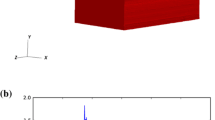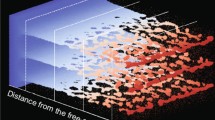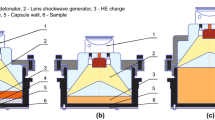Abstract
From detailed numerical simulations and comparison with recent experiments, we explore ejecta production at an interface that is impulsively accelerated by two successive shock waves. The perturbed material interface demarcates the boundary between a metal and vacuum resulting in the formation of ejecta driven by the Richtmyer–Meshkov instability. The numerical simulations were performed with the astrophysical FLASH code, in which the shocked metallic response is conceptually modeled using continuum hydrodynamics. The experimental data were obtained from a two-shockwave, high-explosive tool at Los Alamos National Laboratory capable of generating ejecta from a shocked Sn surface in to a vacuum. In both the simulations and the experiment, linear growth is observed following the first shock event, while the second shock strikes a finite-amplitude interface leading to nonlinear growth. The timing of the second incident shock was varied systematically in our simulations to realize a finite-amplitude re-initialization of the RM instability driving the ejecta. We take advantage of the nonlinear growth following the second shock, to evaluate a recently proposed model for sourcing of mass in ejecta formation that accounts for shape effects through an effective wavelength. In particular, we find the agreement between simulations, experiments and the mass model is improved when such shape effects associated with the interface at the instance of second shock are incorporated. The approach outlined here of combining continuum simulations with validated nonlinear models can aid in the design of future experimental campaigns.












Similar content being viewed by others
References
Lindl JD (1998) Inertial confinement fusion: the quest for ignition and energy gain using indirect drive. Springer, New York
Zingale M, Woosley SE, Rendleman CA, Day MS, Bell JB (2005) Three-dimensional numerical simulations of Rayleigh–Taylor unstable flames in type Ia supernovae. Astrophys J 632 (2):1021
Herant M, Benz W, Hix WR, Fryer CL, Colgate SA (1994) Inside the supernova: a powerful convective engine. Astrophys J 435:339–361
Wang C-Y, Chevalier RA (2001) Instabilities and clumping in type IA supernova remnants. Astrophys J 549 (2):1119
Richtmyer RD (1960) Taylor instability in shock acceleration of compressible fluids. Commun Pure Appl Math 13(2):297
Meshkov EE (1969) Instability of the interface of two gases accelerated by a shock wave. Fluid Dyn 4(5):101
Cherne FJ, Hammerberg JE, Andrews MJ, Karkhanis V, Ramaprabhu P (2015) On shock driven jetting of liquid from non-sinusoidal surfaces into a vacuum. J Appl Phys 118(18):185901
Zellner MB, Byers M, Dimonte G, Hammerberg JE, Germann TC, Rigg PA, Buttler WT (2009) Influence of shockwave profile on ejection of micron-scale material from shocked Sn surfaces: an experimental study. In: DYMAT-International Conference on the Mechanical and Physical Behaviour of Materials under Dynamic Loading, vol. 1. p 89
Zellner MB, Buttler WT (2008) Exploring Richtmyer–Meshkov instability phenomena and ejecta cloud physics. Appl Phys Lett 93(11):114102
Zellner MB, Vogan-McNeil W, Hammerberg JE, Hixson RS, Obst AW, Olson RT, Payton JR, Rigg PA, Routley N, Stevens GD, Turley WD, Veeser L, Buttler WT (2008) Probing the underlying physics of ejecta production from shocked Sn samples. J Appl Phys 103(12):123502
Zellner MB, Vogan-McNeil W, Gray GT III, Huerta DC, King NSP, Neal GE, Valentine SJ, Payton JR, Rubin J, Stevens GD, Turley WD, Buttler WT (2008) Surface preparation methods to enhance dynamic surface property measurements of shocked metal surfaces. J Appl Phys 103(8):083521
Ren G, Chen Y, Tang T, Li Q (2014) Ejecta production from shocked Pb surface via molecular dynamics. J Appl Phys 116(13):133507
Dimonte G, Terrones G, Cherne FJ, Ramaprabhu P (2013) Ejecta source model based on the nonlinear Richtmyer–Meshkov instability. J Appl Phys 113(2):024905
Durand O, Soulard L (2015) Mass-velocity and size-velocity distributions of ejecta cloud from shock-loaded tin surface using atomistic simulations. J Appl Phys 117(16):165903
Ortega AL, Lombardini M, Pullin DI, Meiron DI (2014) Numerical simulations of the Richtmyer–Meshkov instability in solid-vacuum interfaces using calibrated plasticity laws. Phys Rev E 89(3):033018
Charakhch’an AA (2000) Richtmyer–Meshkov instability of an interface between two media due to passage of two successive shocks. J Appl Mech Tech Phys 41(1):23
Buttler WT, Oró DM, Olson RT, Cherne FJ, Hammerberg JE, Hixson RS, Monfared SK, Pack CL, Rigg PA, Stone JB, Terrones G (2014) Second shock ejecta measurements with an explosively driven two-shockwave drive. J Appl Phys 116(10):103519
Buttler WT, Oró DM, Mariam FG, Saunders A, Andrews MJ, Cherne FJ, Hammerberg JE, Hixson RS, Monfared SK, Morris C, Olson RT, Preston DL, Stone JB, Terrones G, Tupa D, Vogan-McNeil W (2014) Explosively driven two-shockwave tools with applications. J Phys Conf Ser 500(11):112014
Meyer KA, Blewett PJ (1972) Numerical Investigation of the stability of a shock-accelerated interface between two fluids. Phys Fluids 15(5):753
Dimonte G, Ramaprabhu P (2010) Simulations and model of the nonlinear Richtmyer–Meshkov instability. Phys Fluids 22(1):014104
Zhang Q (1998) Analytical solutions of Layzer-type approach to unstable interfacial fluid mixing. Phys Rev Lett 81(16):3391
Buttler WT, Oró DM, Preston DL, Mikaelian KO, Cherne FJ, Hixson RS, Mariam FG, Morris C, Stone JB, Terrones G, Tupa D (2012) Unstable Richtmyer–Meshkov growth of solid and liquid metals in vacuum. J Fluid Mech 703:60
Velikovich AL, Dimonte G (1996) Nonlinear perturbation theory of the incompressible Richtmyer–Meshkov instability. Phys Rev Lett 76(17):3112
Mikaelian KO (1998) Analytic approach to nonlinear Rayleigh–Taylor and Richtmyer–Meshkov instabilities. Phys Rev Lett 80(3):508
Mikaelian KO (2010) Analytic approach to nonlinear hydrodynamic instabilities driven by time-dependent accelerations. Phys Rev E 81(1):016325
Asay JR, Bertholf LD (1978) A model for estimating the effects of surface roughness on mass ejection from shocked materials. Sandia Laboratories Technical Report SAND-78-1256
Schwarzkopf JD, Balachandar B, Buttler WT (2017) Compressible multiphase flow. In: Michaelides EE, Crowe CT, Schwarzkopf JD (eds). Multiphase flow handbook, 2nd Edn. CRC Press, Taylor & Francis Group, Boca Raton, pp 455–514
Williams RJR (2016) The late time structure of high density contrast, single mode Richtmyer–Meshkov flow. Phys Fluids 28(7):074108
Fryxell B, Olson K, Ricker P, Timmes FX, Zingale M, Lamb DQ, MacNeice P, Rosner R, Truran JW, Tufo H (2000) FLASH: an adaptive mesh hydrodynamics code for modeling astrophysical thermonuclear flashes. Astrophys J Suppl Ser 131 (1):273
FLASH ASC (2005) Flash user’s guide. University of Chicago, Chicago
Mikaelian KO (1994) Freeze-out and the effect of compressibility in the Richtmyer–Meshkov instability. Phys Fluids 6(1):356
Yang Y, Zhang Q, Sharp DH (1994) Small amplitude theory of Richtmyer–Meshkov instability. Phys Fluids 6(5):1856
Velikovich AL, Herrmann M, Abarzhi SI (2014) Perturbation theory and numerical modelling of weakly and moderately nonlinear dynamics of the incompressible Richtmyer–Meshkov instability. J Fluid Mech 751:432
Mabire C, Hereil PL (2000) Shock induced polymorphic transition and melting of tin. In: AIP Conference Proceedings, vol 505, no 1, p 93
Mabire C, Hereil PL (2000) Shock induced polymorphic transition and melting of tin up to 53 GPa (experimental study and modelling). J Phys IV 10(PR9):749
Greeff C, Chisolm E, George D (2005) SESAME 2161: an explicit multiphase equation of state for tin. Los Alamos National Laboratory Tech Rep. LA-UR-05-9414
Zel’dovich YB, Raizer YP (1996) Physics of shock waves and high-temperature hydrodynamic phenomena. Academic, INC, San Diego, CA
Buttler WT, Zellner MB (2007) Tin ejecta data review: toward a statistical material fragmentation model. Los Alamos National Laboratory Tech. Rep. LA-UR-07-6522
Assael MJ, Kalyva AE, Antoniadis KD, Banish RM, Egry I, Wu J, Kaschnitz E, Wakeham WA (2010) Reference data for the density and viscosity of liquid copper and liquid tin. J Phys Chem Ref Data 39(3):033105
Mikaelian KO (2013) Shock-induced interface instability in viscous fluids and metals. Phys Rev E 87(3):031003
Acknowledgements
This work was supported in part by the (U.S.) Department of Energy (DOE) under Contract No. DE-AC52-06NA2-5396. FLASH was developed by the DOE-sponsored ASC/Alliance Center for Astrophysical Thermonuclear Flashes at the University of Chicago.
Author information
Authors and Affiliations
Corresponding author
Rights and permissions
About this article
Cite this article
Karkhanis, V., Ramaprabhu, P., Buttler, W.T. et al. Ejecta Production from Second Shock: Numerical Simulations and Experiments. J. dynamic behavior mater. 3, 265–279 (2017). https://doi.org/10.1007/s40870-017-0091-9
Received:
Accepted:
Published:
Issue Date:
DOI: https://doi.org/10.1007/s40870-017-0091-9




